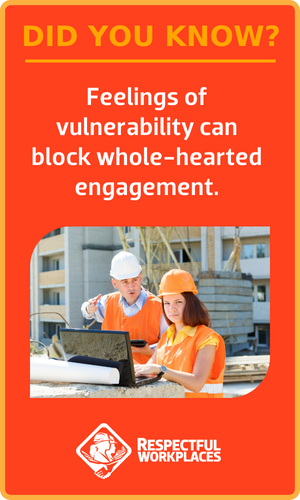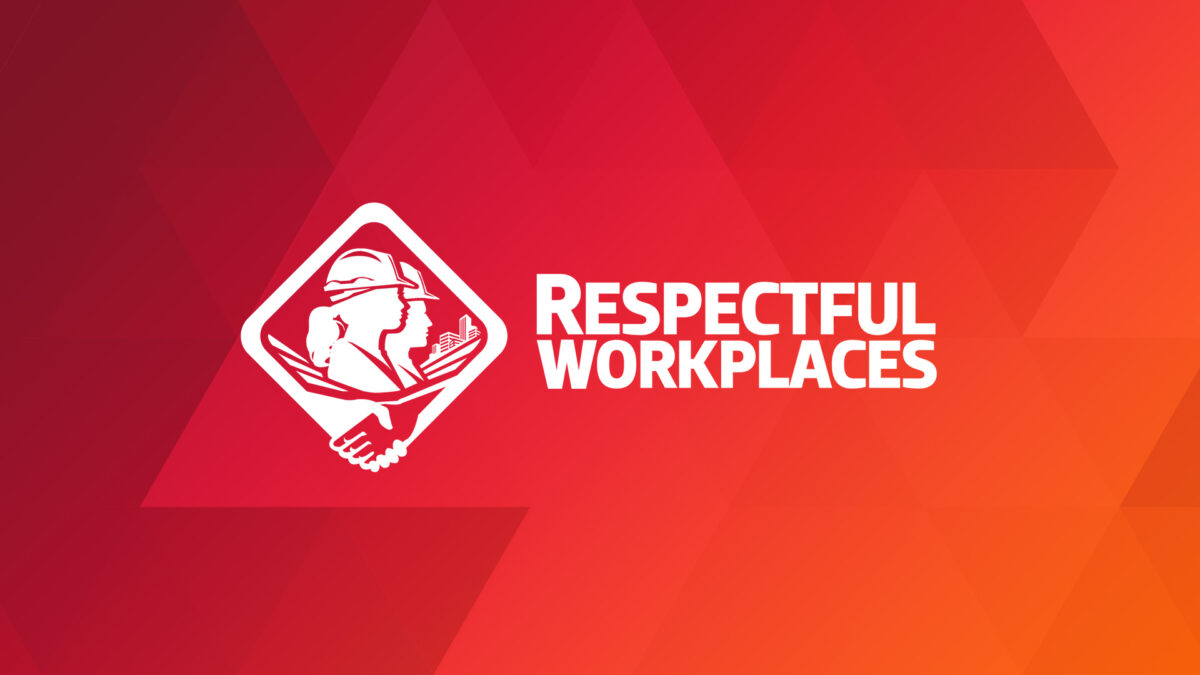Does your organization develop courageous leaders who enable whole-hearted engagement?

A new year is a time for reflection on the challenges of the previous year, the successes and failures, and the challenges of the new year. Organizations are struggling to transition from pandemic conditions, integrate hybrid work options, and manage supply-chain interruptions, all in an inflationary world economy.
For the construction sector, an added challenge is the unprecedented labour shortage in our industry. As of July 2022, the number of job vacancies in construction has never been higher – a trend that will continue. BuildForce Canada estimates that 156,000 individuals are expected to retire from construction by 2027, meaning the industry will need to recruit an estimated 171,850 workers by the same year.
In order to meet this challenge, the Canadian construction industry will need to ensure that it can attract and retain not only younger workers, but those from demographically diverse applicant pools as well.
To attract and retain younger workers, organizations need to create a culture where workers can bring their whole selves and whole hearts to work. Research shows that younger workers are more engaged in organizations in which they can speak up with ideas, questions, or concerns without the fear of negative consequences. Younger workers are also more likely to stay at organizations where they have a sense of purpose and belonging.
In addition, demographic diversity itself has an impact on the ability to attract and retain younger workers. When they perceive their organization and senior management as diverse and inclusive, younger workers see their working environment as motivating and stimulating. They are also more likely to perceive that their organization performs strongly in generating profits.
This means that construction organizations will need to be inclusive of younger workers from traditionally under-represented groups, such as women, members of Black, Indigenous, and People of Colour communities, LGBTQ2S+ workers, and newcomers. Leaders will need to change a workplace culture that is perceived to be unwelcoming to members of these applicant pools, resistant to change, and not diverse.
According to the research of Brené Brown, author of Dare to Lead, the obstacle to creating an inclusive workplace culture that enables whole-hearted engagement and eliminates forms of fear-based leadership such as racism and sexism, is vulnerability.
Vulnerability is the emotion that we experience during times of uncertainty, risk, and emotional exposure. Discussions about racism and sexism or other challenges make us vulnerable to the opinions and actions of others. Rather than expose our feelings, concerns, or mistakes to others, we “armour up”: that is, we use defense mechanisms, hide our failures, and blame others.
This creates barriers between us and our co-workers, between us and the challenges we face, between us and our emotions, and true moments of understanding and connection with our team.
How do leaders address vulnerability to enable whole-hearted engagement? Brown explains that there was one answer across her interviews with senior leaders: we need braver leaders and more courageous cultures.
Courageous leadership
Brown has identified four practices that define courageous leadership:
1. Rumbling with vulnerability
2. Living into our values
3. Braving trust
4. Learning to rise
1. Rumbling with vulnerability
Brown argues that courageous leaders don’t avoid feelings of vulnerability; instead, they use them as a tool for exploring failure in ourselves and our organizations, surfacing new ideas, and living with uncertainty.
“Rumbling” is a discussion, conversation, or meeting defined by mutual agreement, set aside specifically to lean into vulnerability, stay curious and generous, stick with the messy middle of problem identification and solving, take a break and circle back, when necessary, be fearless in owning our part in it, and listen with the same passion with which we want to be heard.
2. Living into our values
A value is a way of being or a belief that we hold to be important. Living into our values means that we do more than profess them; we practice them. Brown asks leaders to identify the two most important values they hold. The importance of the exercise is to narrow the list down to the two central values that fuel every other value in your life.
Because we often face situations that challenge our values, they should be so crystallized in our minds that they don’t feel like a choice; they are simply a definition of who we are. This becomes important in situations that don’t align with our values. If we don’t speak up, we may avoid the vulnerability but we risk losing our whole-hearted engagement.
3. Braving trust
Trust is defined as sharing something that you value with another person that makes you vulnerable to that person’s actions or opinions. Distrust occurs when you decide that something that is important to you is not safe to share with a specific person in a specific situation. But because talking about trust is difficult, we often avoid the rumble.
The solution is to identify the specific behaviour, without criticizing the individual. It also helps if the organization has engaged in “container building”: purposely establishing the ground rules for discussing trust so that people can be fully engaged, without fear of negative consequences.
4. Learning to rise
The participants in Brown’s research who had the highest levels of resilience use a process that she calls “learning to rise.” Brown’s research shows that leaders who know how to get back up after a failure are more likely to engage in courageous behaviours.
We are emotional beings, and when something hard happens to us, emotions can take over. However, “risers” immediately recognize when they’re emotionally hooked by something. They recognize that if they are playing a conversation over and over or feel disappointed, regretful, or hurt, they need to explore why.
One of the most useful applications of the learning-to-rise process is “the story rumble.” It is a process that reflects on the negative stories we make up about ourselves, others, or situations to avoid vulnerability. The process includes establishing a container for the process: creating a shared understanding of how to constructively discuss failure or overwhelming challenge.
In order to meet the challenges ahead, leaders must create a workplace culture that enables whole-hearted engagement. These organizations will be able to attract and retain younger workers, including those from traditionally under-represented groups. This will take courageous leaders willing to rumble with vulnerability to create the inclusion and connections needed to thrive and excel in our complex, rapidly changing world.
Leaders and managers who wish to understand the barriers that prevent whole-hearted engagement such as racism and sexism could consider participating in two of the courses in our Respectful Workplace Online Toolkit: Working in a Respectful and Inclusive Workplace and Introduction to Understanding Systemic Racism – A Guide for Leaders and Managers. These courses help participants to live into the values around inclusion and identify the false stories that prevent whole-hearted engagement.
Resources:
- Brown, Brené. Dare to Lead: brave work, tough conversations, whole hearts. New York Random House, 2018.
- BuildForce Canada Magazine, Fall 2022. See page 9: http://flip.matrixgroupinc.net/bfca/2022/fall/#page=9.
- Deloitte. The Deloitte Global 2022 Gen Z and Millennial Survey. See: www2.deloitte.com/global/en/pages/about-deloitte/articles/genzmillennialsurvey.html.
- Edmondson, Amy C. The Fearless Organization. New Jersey, U.S.A., John Wiley & Sons, 2019.
- Winters, Mary-Frances. We Can’t Talk About that at Work! Oakland California, U.S.A., Berrett-Koehler Publishers, Inc. 2017.
Read from the beginning. Click here to start at Part 1.
What can an effective Respectful and Inclusive Workplace Program deliver?
- Become an employer of choice – attract, retain, and advance top talent from all sources of labour
- Unlock collaboration and innovation – create high-performing teams through diversity of thought and experience
- Build your brand – your organization will gain a competitive edge as a leader and innovator
Get started today!
The BuildForce Canada Online Respectful and Inclusive Workplace Toolkit includes:
- the Respectful Workplace Online Self-Assessment Tool to assist organization leadership in assessing their current situation and identifying where they may need to make changes
- the Respectful Workplace Policy Framework and Implementation Guide to assist organizations in creating and implementing a policy that supports a respectful and inclusive workplace
- the Respectful Workplace Online Training Course to train workers on how to create and support a respectful and inclusive workplace
- the online course Introduction to Understanding Systemic Racism: A Guide for Leaders and Managers
All the resources you need to create and support a respectful and inclusive workplace!

Respectful and Inclusive Workplaces
